Part 1:
To see how the data would match, you may want to try turning this into letters, instead of pluses.
<div class="one">
g
tuv
J
</div>
<div class="two">
a b cdef g hi j k l
m no pqr s tuv wx y zAB
C DE F G HI J K L M NO
</div>
You'd have to do something like this:
Since: one.innerText = g \n tuv \n J
It would need to be turned into a regular expression like: /g|tuv|J/g
To see the cross matching, copy & paste the contents of class two into this site & delete the spacing before "a", "m" & "C": http://regexr.com/3eumc
Part 2
The problem is if "tuv" moves around in string 2, it wouldn't be locked with "g" above "u" above "J".
To fix that "g" above "u" above "J" problem, we'd have to think of this as a 2-dimensional dataset for a game board. That means turning the string into a matrix (array of arrays), where each letter plus each space gets dropped into an array slot. Like so:
var matrix = [
// 1 2 3 4 5 6 7 8 9 0 1 2 3 4 5 6 7 8 9 0 1 2 3 = columns. Remember to add +10, +20!
[a| |b| | | |c|d|e|f| | |g| |h|i| | |j| |k| |l], // row 0
[m| |n|o| |p|q|r| |s| |t|u|v| |w|x| |y| |z|A|B], // row 1
[C| |D|E| |F| |G| |H|I| |J| |K| |L| |M| |N|O] // row 2
];
Now you can check to see if:
if ((matrix[0][13] === 'g')
&& (matrix[1][12] === 't') && (matrix[1][13] === 'u') && (matrix[1][14] === 'v')
&& (matrix[2][13] === 'J')) {
/* SUCCESS when all 5 letters appear & "g" is above "u" & "u" is above "J".
The entire cross can move left or right, but lines 1, 2 & 3 can't shift
independently of the other 3 lines. Otherwise it should fail.
*/
} else {
// FAIL
}
Part 3...
I've solved this matrix search puzzle. See my jsFiddle at https://jsfiddle.net/briankueck/pern32vv/
Here is the core of how the code looks. Turn on the debugging switch at that jsFiddle link to see how it runs. :)
function getMatrix(cssSelector, canTrim) {
// Built by, Clomp! @briankueck http://www.clomp.com
var obj = $(cssSelector);
if (obj) {
var matrix = obj.text()
/* Makes sure that we are selecting 3 lines, not 5
* as the example has a \n after <div ...>\n and before \n</div>
*/
if (canTrim) {
matrix = matrix.trim();
}
// Now split those 3 lines.
matrix = matrix.split(/\n/);
/* Trims each array in the matrix. Note: matrix[row] is a string,
* but we can treat a string as an array of characters.
*/
if (canTrim) {
// Trims each row, if desired.
for (var row = 0; row < matrix.length; row++) {
matrix[row] = matrix[row].trim();
}
} else {
// Gets rid of spaces before matrix 1 in this demo.
var maxLength = 0;
var space = ' '; // You can also use a period here to see how it works.
var tempMatrix = [];
for (var row = 0; row < matrix.length; row++) {
// This cuts the rows down (vertically) from 5 to 3.
if (matrix[row].trim().length > 0) {
matrix[row] = matrix[row].replace(/\s/g, space);
matrix[row] = matrix[row].replace(/\t/g, space);
tempMatrix.push(matrix[row]);
if (matrix[row].length > maxLength) {
maxLength = matrix[row].length;
}
}
}
/* This loops those 3 rows (horizontally) & slices the 1st character off
* each array if they are all identical & only contain spaces, which we are
* tracking with the period character '.' as dots.
*/
var charactersToStrip = 0;
for (var column = 0; column <= maxLength; column++) {
for (var row = 0; row < tempMatrix.length; row++) {
if (tempMatrix[row][column] !== space) {
break;
} else if (row === (tempMatrix.length - 1)) {
charactersToStrip++;
}
}
}
/* Strips characters, without removing the space before "g"
* and the space before "J".
*/
for (var column = 0; column < charactersToStrip; column++) {
for (var row = 0; row < tempMatrix.length; row++) {
tempMatrix[row] = tempMatrix[row].substring(1);
}
}
matrix = tempMatrix;
}
}
return matrix;
}
function matrixSearch(matrixOne, matrixTwo) {
// Built by, Clomp! @briankueck http://www.clomp.com
var space = ' '; // You can also use a period here to see how it works.
// This is for " g". First we trim it, as we only want the "g" character.
var searchChar = matrixOne[0].trim();
// Next we find the lock position.
var firstCharPosition = matrixTwo[0].indexOf(searchChar);
var matchingRows = -1;
if (firstCharPosition > -1) {
// This should be 1 & not 0.
var matchingCharInMatrixOne = matrixOne[0].indexOf(searchChar);
// Now we can find the starting index of character 0 in each row of matrixTwo:
var startIndex = firstCharPosition - matchingCharInMatrixOne;
// This simultaneously scans rows 1, 2 & 3 in both matricies.
var matchingRows = 0;
for (var row = 0; row < matrixOne.length; row++) {
/* We now know both the startIndex = 11 & the lock position = 12.
* So let's use them for "tuv" and " J".
*/
var endIndex = startIndex + matrixOne[row].length;
var i = -1;
for (var column = startIndex; column < endIndex; column++) {
i++;
if (matrixOne[row][i] !== space) {
var matrixOneCharacter = matrixOne[row][i];
var matrixTwoCharacter = matrixTwo[row][column];
if (matrixOneCharacter !== matrixTwoCharacter) {
break;
} else if (column === (endIndex - 1)) {
// Found it!
matchingRows++;
}
}
}
}
}
// Now we can find it:
var isFoundInMatrixTwo = ((matchingRows > -1)
&& (matchingRows === matrixTwo.length)) ? true : false;
return isFoundInMatrixTwo;
}
var cssSelector1 = '.one';
var cssSelector2 = '.two';
var matrixOne = getMatrix(cssSelector1, false);
var matrixTwo = getMatrix(cssSelector2, true);
var isFound = matrixSearch(matrixOne, matrixTwo);
console.log('Is matrix 1 in matrix 2? ', isFound);
Enjoy!
Btw, Merry Christmas Stack Overflow community from Clomp!
